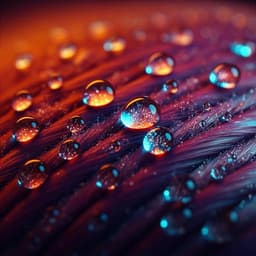
Engineering and Technology
Photocatalytically reactive surfaces for simultaneous water harvesting and treatment
R. Ghosh, A. Baut, et al.
This innovative research conducted by Ritwick Ghosh, Adrien Baut, Giorgio Belleri, Michael Kappl, Hans-Jürgen Butt, and Thomas M. Schutzius unveils a cutting-edge system that captures fog and cleans organic pollutants simultaneously. Utilizing sunlight-activated TiO2 nanoparticles on a specialized wire mesh, this solution not only addresses water scarcity but does so without requiring energy. Discover how outdoor tests reveal impressive water treatment efficiencies exceeding 85%.
~3 min • Beginner • English
Introduction
The study addresses the challenge of harvesting atmospheric water (particularly fog) in polluted environments, where collected water can contain organic contaminants. While fog harvesting is a promising, energy-neutral method capable of yielding substantial volumes, contamination limits utility near population centers. Prior design efforts optimized mesh geometry and wettability to increase capture efficiency and drainage, but typically considered uncontaminated fog. The authors propose a passive system that both harvests fog and degrades organic pollutants by integrating photocatalytically reactive TiO2-based coatings onto meshes. The key research questions are whether such coatings can remain reactive without continuous illumination and how surface wettability and droplet dynamics control treatment rates during fog collection.
Literature Review
The paper builds on literature optimizing fog collection through mesh architecture (wire diameter, spacing, and patterns), wettability engineering to reduce re-entrainment, and strategies for droplet transport (Laplace pressure gradients, wettability patterns, asymmetry). Reported maximum collection efficiencies for lab-scale, low-wind conditions are typically ~12–17%. Urban fogs contain organic pollutants (0.3–25 ppm). Anatase TiO2 photocatalysis is well-established for degrading organic contaminants and biofilms under UV. Previous fog-harvester studies with TiO2 coatings required continuous UV irradiation and achieved limited removal (<36%), with limited exploration of underlying mechanisms. The present work advances this by enabling intermittent activation (retaining reactivity in the dark), integrating wettability control, and establishing a diffusion–adsorption–reaction framework for design.
Methodology
Coating design and preparation: Two nanoengineered reactive coatings were developed by embedding TiO2 nanoparticles (Aeroxide P25; 77.1% anatase, 15.9% rutile) into polymer binders and grafting a PDMS brush to tune wettability and adhesion. Hydrophilic reactive coating: TiO2-PVB-PDMS (TiO2 in polyvinyl butyral binder with PDMS brush). Hydrophobic reactive coating: TiO2-EC-PDMS (TiO2 in ethyl cellulose binder with PDMS brush). Substrates were glass slides and stainless-steel meshes (SS304; wire diameter 2R = 0.25 mm; spacing 2G = 0.6 mm; orthogonal grid). Coating dispersions: TiO2 in ethanol (0.02 g ml−1), sonicated 1 h; binder added (0.001 g ml−1), stirred 30 min. Sprayed (3 bar, ~20 cm) on substrates; glass coated one side; meshes both sides; dried 60 °C for 1 h. PDMS brush grafting: oxygen plasma (3 min, 100 W); immersion in toluene:dichlorodimethylsilane (30:1 v/v) for 30 min; rinsed with toluene and DI water. UV activation: 365 nm lamp, 165 W m−2 for 30 min (approximately triple solar intensity), or sunlight; activation renders TiO2-PVB-PDMS hydrophilic and TiO2-EC-PDMS hydrophobic. XPS/X-EDS confirmed stable PDMS brush and composition differences depending on binder. Wettability parameters (advancing/receding angles) were characterized; TiO2-PVB-PDMS exhibits low hysteresis and favorable drainage behavior after activation.
Single-droplet purification experiments: Epifluorescence microscopy imaged fluorophore-containing water droplets (fluorescein; typical V = 5 μl; varied volumes) on coated glass to quantify decay by monitoring normalized fluorescence intensity (I/I0) at the droplet–substrate interface over time. UV-vis colorimetric tests with methyl orange (MO) droplets (C0 typically 25 ppm) corroborated decomposition. Additional tests with diesel-in-water (C0 = 0.75 ppm; 100 μl emulsion) and bisphenol A (C0 = 0.15 ppm; 3,000 μl) in TiO2-PVB-PDMS-coated Petri dishes evaluated real-world contaminants.
Transport-reaction modeling: Degradation modeled as 1D diffusion (Fick’s second law) with no-flux at liquid–air interface and exponential decay boundary at the reactive surface following Langmuir–Hinshelwood adsorption kinetics. Characteristic times: diffusion H2/D and adsorption 1/ka; H ~ V/A. Best fits to experimental I/I0(t) identified adsorption-limited regime for hydrophilic TiO2-PVB-PDMS (ka H2/D ≪ 1; H ≈ 10 μm) and diffusion-limited regime for hydrophobic TiO2-EC-PDMS (ka H2/D ≫ 1; H ≈ 1.9 mm). Predicted scaling of decay time t* with droplet volume: t* ∝ V1/3 (adsorption-limited) and t* ∝ V2/3 (diffusion-limited); verified experimentally.
Laboratory fog harvesting and treatment: Custom acrylic fog tunnel (diameter Φ = 6 cm; length 15 cm) with ultrasonic humidifier generated artificial fog containing MO at controlled initial concentrations (C0). Fog velocity ufog = 1.5 m s−1; mass flux ≈ 0.036 g cm−2 min−1. Mesh (6 × 6 cm2) mounted at end; collected water drained into a reservoir on a balance; runs of Δt = 66 min. Collected mass mc yielded fog harvesting efficiency mc/(mΔt). Treatment efficiency measured by comparing collected concentration C to C0: (1 − C/C0). Image analysis of droplet color (blue-channel attenuation) in inter-wire regions tracked in situ MO concentration changes during runs. Mesh geometry: wire radius R = 125 μm; spacing 2G = 600 μm.
Residence time analysis: Estimated average water-substrate residence time t1 from drainage velocity and geometry: t1 = LR ρ W / mc, yielding t1 ≈ 20 min for representative conditions (ρ = 1.0 g cm−3, W = 6.0 cm, L = 6.0 cm, R = 0.0125 cm, mc = 0.023 g min−1). Compared t1 to single-droplet treatment time estimates for droplets on hydrophobic meshes.
Outdoor experiments: Entire fog-harvesting setup deployed on ETH Zurich rooftop. Sunny tests: 25–29 July 2022, 10:00–16:00, UV index 7, temperature 25–33 °C. Cloudy tests: 10–14 and 24–28 January 2023, UV index 0, temperature 8–9 °C. TiO2-PVB-PDMS meshes were pre-activated; under sunny conditions additional continuous solar activation occurred. Treatment efficiencies (1 − C/C0) measured across C0 from 0.5 to 25 ppm.
Key Findings
- Coating functionality and dark reactivity: TiO2 nanoparticle coatings activated by brief UV exposure remain reactive for hours in the absence of illumination, enabling passive purification during foggy, low-irradiance conditions.
- Single-droplet degradation performance: On TiO2-PVB-PDMS (hydrophilic), MO-contaminated droplets (V = 5 μl, C0 = 25 ppm) became clear in ~30 min; on TiO2-EC-PDMS (hydrophobic) in ~250 min. Diesel-in-water (C0 = 0.75 ppm; 100 μl) on TiO2-PVB-PDMS was reduced by 99.9% in 30 min; bisphenol A (C0 = 0.15 ppm; 3,000 μl) became undetectable after 30 min.
- Mechanistic regimes and scaling: Epifluorescence measurements showed I/I0 decay consistent with adsorption-limited kinetics on hydrophilic coatings and diffusion-limited kinetics on hydrophobic coatings. Decay time scaling with droplet volume: t* ∝ V1/3 (TiO2-PVB-PDMS) and t* ∝ V2/3 (TiO2-EC-PDMS). Best-fit non-dimensional parameters indicated ka H2/D ≈ 2.2×10−4 (adsorption-limited) vs ≈ 3.3 (diffusion-limited). Increasing contaminant concentration (C0) increases adsorption limitation; increasing droplet height H increases diffusion time.
- Laboratory fog tests (ufog = 1.5 m s−1; mass flux ~0.036 g cm−2 min−1; Δt = 66 min): Fog harvesting efficiencies: uncoated 5.6%, TiO2-PVB-PDMS 8.0%, TiO2-EC-PDMS 3.8%. Treatment efficiency (1 − C/C0): For TiO2-PVB-PDMS, 91% at C0 = 0.5 ppm (near regulatory limits), and 14% at C0 = 25 ppm. Total organic carbon reduction on TiO2-PVB-PDMS: 60% at C0 = 7 ppm and 12% at C0 = 25 ppm. In situ imaging showed progressive yellowing under high C0 due to limited residence time vs treatment time.
- Residence time linkage: Estimated average residence time t1 ≈ 20 min; for hydrophobic meshes, droplet treatment time t ≈ 36 min for V ≈ 0.3 μl at C0 = 25 ppm, yielding t/t1 ≈ 0.56, consistent with measured modest treatment efficiencies at high C0.
- Outdoor performance: With UV index 7 (sunny), TiO2-PVB-PDMS meshes achieved treatment efficiencies from ~94% (C0 = 0.5 ppm) down to ~39% (C0 = 25 ppm) due to continuous solar activation. Under UV index 0 (cloudy) with pre-activation, treatment efficiencies remained high (around 85% at low C0) and followed similar trends to lab results, demonstrating dark reactivity and passive operation.
- Hydrophilic vs hydrophobic meshes: TiO2-PVB-PDMS outperformed TiO2-EC-PDMS in both fog collection and purification, attributed to lower contact angle hysteresis, lower receding angle, larger contact area, and reduced diffusion lengths for contaminants.
Discussion
The results demonstrate a passive, energy-neutral approach to simultaneously harvesting fog and degrading organic pollutants by integrating UV-activated, TiO2-based reactive coatings into fog meshes. The coatings retain reactivity in the dark, addressing the practical constraint of low irradiance during fog events. Mechanistic analysis shows that hydrophilic coatings operate in an adsorption-limited regime with short diffusion paths, enabling faster decay times and higher treatment efficiency during the limited residence time on meshes. Hydrophobic coatings are diffusion-limited, leading to slower treatment. Lab-scale fog tests confirmed that the hydrophilic TiO2-PVB-PDMS mesh improves both harvesting efficiency and contaminant decay, achieving near-complete removal at regulatory-relevant concentrations (≤0.5 ppm). Outdoor experiments validated performance under real solar exposure and on cloudy days with pre-activation, linking higher treatment to continuous activation by sunlight. The integration of wettability design and maximized TiO2 loading while maintaining adhesion underpins the device’s effectiveness and provides design rules via the diffusion–adsorption–reaction model.
Conclusion
This work introduces a solar-activated, photocatalytically reactive mesh that passively harvests fog water and degrades organic contaminants with high efficiency. A hydrophilic TiO2-PVB-PDMS coating delivers superior fog collection and purification, supported by mechanistic scaling laws (t* ∝ V1/3 vs V2/3) and dark reactivity after brief UV activation. In laboratory tests, harvesting reached ~8% with strong treatment at low contaminant levels (91% at 0.5 ppm), and in outdoor trials, treatment efficiencies reached ~94% (sunny) and remained ~85% under low UV conditions. The findings establish rational design guidelines based on wettability control, residence time management, and diffusion–adsorption kinetics. Future work could optimize mesh architecture to balance collection and residence time, extend performance to broader pollutant classes and concentrations, scale to larger installations, and evaluate long-term durability and fouling in natural fog environments.
Limitations
- Treatment efficiency decreases at higher contaminant concentrations (e.g., MO at 25 ppm), with (1 − C/C0) ~14% in lab tests and modest TOC reductions (12%), indicating residence-time and kinetics constraints under high pollutant loads.
- System performance depends on prior UV activation; while coatings retain dark reactivity for hours, prolonged dark operation without intermittent activation may reduce treatment rates.
- Laboratory evaluations used artificial fog and controlled conditions; natural fog variability (droplet size distribution, airflow, pollutant mix) and long-term durability or fouling effects require further study.
- Hydrophobic reactive meshes showed lower collection and treatment due to diffusion limitations, limiting applicability unless geometry or residence time is increased.
Related Publications
Explore these studies to deepen your understanding of the subject.







